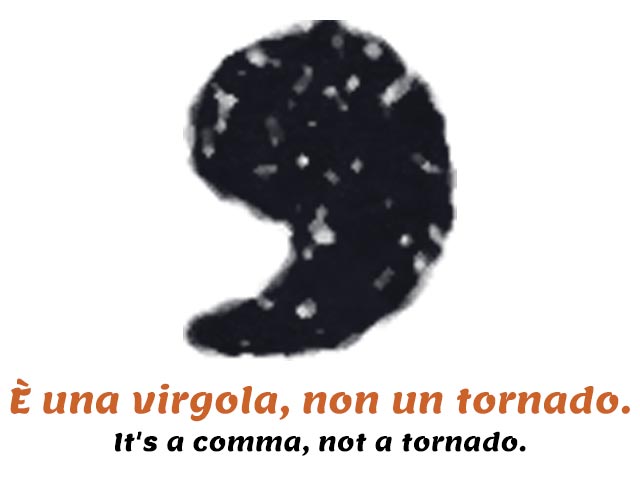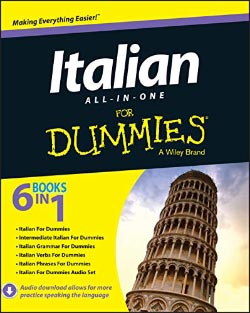Italian punctuation rules are more flexible than grammar rules, but it’s still important for you to know the general guidelines that dictate how to use periods, exclamation points, and commas in Italian.
Let’s start with the definition of a comma, or virgola in Italian: a comma is a short pause that allows you to breathe and gives rhythm to your speech. My Italian teacher used to tell us, “tap your index finger once on the table and you get a comma, tap it twice and you get a period”.

In this lesson, we’ll see how to use commas in Italian once and for all. You will also find audio recordings to help you understand just what kind of pause a comma is.
Iniziamo! Let’s get started!
Using commas in Italian
When NOT to use a comma
It’s actually easier to start with situations where you can’t use commas, otherwise you will get a slap on the wrist from your teacher.
No comma between the subject and the predicate (the conjugated verb)
Il gatto mangia.
The cat is eating.
Don’t use commas between gatto and mangia.
Il gatto mangia, la mamma cucina.
The cat eats, mom cooks.
Now for the reason why you can’t use any commas between a subject and its verb in Italian…
Il gatto mangia la mamma, cucina.
The cat eats the mom, it cooks.

Cats should be eating cat food, cibo per gatti, not moms!
No comma between the predicate (the conjugated verb) and the following direct object
Il gatto mangia la mamma.
The cat eats the mom.
Mamma is a direct object here. A direct object is the direct “recipient” of the action conveyed by the verb. Who is being eaten by the cat? Mom.
The punctuation in this sentence is correct, although its meaning is somewhat questionable.
Il gatto mangia, la mamma.
The cat eats, the mom.
This sentence, however, is wrong. In Italian, you just don’t put commas between a verb and its… victim.
No comma before the last item in a list
This can be tricky for English speakers because English punctuation rules require you to put a comma between all items in a list and before the last element in the list itself (I tend to overlook this rule in English and Grammarly is always telling me off for it).
But this doesn’t work in Italian.
Devo comprare pane, uova, latte, sottaceti e merendine.
I need buy bread, eggs, milk, pickles and snacks.
You can’t put a comma before e merendine. You can put a comma before the last element if there’s no conjunction. However, it’s much more common to put an e before the last element.
L’ho chiesto a Marta, Andrea, Federico, Simone.
I asked Marta, Andrea, Federico, Simone.

No commas in Italian before a main clause and an indirect question or a subject/object clause
I can’t really explain what subject and object clauses are because I’d be going off topic, but suffice it to say that the English rules work the same way here. If you don’t feel like putting a comma in your Italian sentence when you translate it into English, you probably don’t need to put any commas in Italian. Watch out for question words like quando, perché and dove as well as che (that).
Chiedi a Luca se ha già finito i compiti.
Ask Luca if he has finished his homework yet.
(indirect question, no comma between Luca and se)
Mi preoccupa che Dario non sia ancora tornato.
It worries me that Dario is not back yet.
(subject clause, no comma between preoccupa and che)
Vedo che non hai ancora finito i compiti!
I see that you haven’t finished your homework yet!
(object clause, no comma between vedo and che)
When you DO use a comma
Now let’s talk about when you can use commas in Italian.
Use a comma between all but the last item in a list
This follows the rule about not putting a comma before the last element in a list in Italian. As in English, you will place a comma between all elements except the last one. The list itself can consist of nouns, verbs or even adjectives.
Mi piace camminare, mangiare, lavorare e dormire.
I like to walk, eat, work and sleep.
Marco è alto, bello e magro.
Marco is tall, handsome and thin.

Use commas to enclose an aside (parenthetical elements)
Asides in English are usually introduced by which/who and add non-essential information to a sentence.
L’uomo, che lavorava a Londra, si chiamava Piero.
The man, who worked in London, was called Piero.
Le lucertole, che sono dei rettili, possono correre molto velocemente.
Lizards, which are reptiles, can run very fast.
Stefania, non sapendo come rispondere, rimane zitta.
Stefania, not knowing how to answer, remains silent.
Use commas in Italian before ma, però, tuttavia, anzi
Ma, però and tuttavia translate to but, however, while anzi means on the contrary. Make sure you add a comma before all of these.
Vorrei mangiare qualcosa, ma non c’è nulla in frigo.
I would like to eat something, but there is nothing in the fridge.
Luca non è mai in ritardo, anzi è sempre in anticipo.
Luke is never late; in fact, he is always early.

Use a comma before or after a proper noun when addressing someone
You use commas in Italian before or after a proper name when addressing someone (vocative), depending on its position in the sentence.
Sara, hai visto la mia borsetta rossa?
Sara, have you seen my red handbag?
Grazie del regalo, Mattia.
Thank you for the gift, Mattia.
Dimmi, Eleonora, perché non hai fatto i compiti.
Tell me, Eleonora, why you didn’t do your homework.
Use a comma after an introductory sentence
That said, first things first, in the beginning etc. are all introductions to a main clause. Separate these with commas in Italian.
Detto questo, passiamo alla prossima domanda.
That said, let’s move on to the next question.
Prima di tutto, controlliamo cosa c’è nel pacco.
First, let’s check what’s in the box.

Use commas in Italian to separate main and subordinate clauses
You add commas in Italian to separate some subordinate clauses introduced by conjunctions from their main clauses, or vice versa.
Mangia un panino, se hai fame.
Eat a sandwich if you are hungry.
(main + subordinate, this works differently from English!)
Se hai già cenato, sparecchia la tavola.
If you have already had dinner, clear the table.
(subordinate + main)
Dato che nevica, non andremo al parco.
Since it is snowing, we will not go to the park.
(subordinate + main)
Nonostante fossi stanco, non riuscivo a dormire.
Although I was tired, I could not sleep.
(subordinate + main)

Use commas in Italian to separate elements in a date
Milano, 14 agosto 2022.
Milan, August 14, 2022.
Roma, 22 settembre 2022.
Rome, September 22, 2022.
Commas in Italian with numbers
The English punctuation rules for dividing large numbers are very different from those in Italian. In fact, the rules that dictate how to write large numbers in Italian are reversed:
- use commas in Italian to separate decimals
- use periods to separate thousands and larger numbers
For example, compare these numbers…
24.562
24,562
347.900
347,900
3,14
3.14
(This is π, it’s a decimal!)
And that’s it for our guide to the commas in Italian! If you still have any doubts about them, feel free to leave a comment.
What next?
Now that you’ve seen how to use commas in Italian, you might want to keep learning Italian online with these free Italian resources:
- Useful Italian Words Series
- Common Italian Phrases Series
- Italian grammar lessons and tricks
- Italian idiomatic expressions
Or you might also want an excellent offline Italian grammar resource to take with you at all times (Amazon).
Title: Italian All-in-One For Dummies
Language: English / Italian
Publisher: For Dummies
Pages: 672
Learn to speak Italian like a native? Easy.
Italian All-in-One For Dummies appeals to those readers looking for a comprehensive, all-encompassing guide to mastering the Italian language. It contains content from all For Dummies Italian language instruction titles, including Italian For Dummies, Intermediate Italian For Dummies, Italian Verbs For Dummies, Italian Phrases For Dummies, Italian Grammar For Dummies, and Italian For Dummies Audio Set.
❤️ If you liked this guide on how to use commas in Italian, consider sharing it with your social media friends who are also studying Italian.




